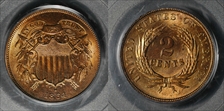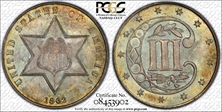Golbrecht's Raisinet Collection 的钱币相册
1864 2C Large Motto MS65RD. A fiery, very premium quality Gem of this important and widely collected odd denomination. Millions were struck of this first year issue, but full red Gems are anything but common. The surfaces of this coin display a vibrant and totally original orange-red color that barely shows just a whisper mellowing in the nearly 15 decades since its Civil War era origin. The mint red color is virtually undiminished by the passage of time, appearing today much as it did in 1864, the year Colonel Chivington massacred the Southern Cheyenne at Sand Creek. This unusual denomination was created to help fill the yawning gap in circulating coinage that resulted from the widespread hoarding of coins in the early 1860s. An historic issue designed by James Barton Longacre that is indelibly linked with the Civil War, the 1864 two cent piece is also the first U.S. coin to bear the motto IN GOD WE TRUST. The present example is the second and more commorn of the two varieties produced this year. The earlier Small Motto coins were prototypes and modified after only a few thousand were struck, with the motto enlarged on subsequent strikings. Far fewer of the Small Motto coins are seen today with full red color than of their Large Motto counterparts. Held back from an even higher grade only by light, scattered flyspecks, and uncommonly attractive even for the MS65 grade, this Large Motto Gem shows nearly full mint-red color. Both sides are intensely lustrous, with vivid crimson-orange color. All features show pinpoint striking definition, with with good detail to the highpoints. The lustrous and unabraded surfaces have no obtrusive contact marks, and only negligible carbon.
1862/1 3CS MS66. The left half of the 2 in the date has a faint but nearly complete 1. The underdigit is faint but clearly discernible with a magnifier. Bold die clash marks are evident on this scarce overdate variety, especially on most of the obverse shield within the III. Very sharply struck for a Type Three, this piece shows exceptionally pronounced evidence of die clashing, and that is saying a lot for a three cent silver as they are usually die clashed.
1862/1 3CS MS66. The left half of the 2 in the date has a faint but nearly complete 1. The underdigit is faint but clearly discernible with a magnifier. Bold die clash marks are evident on this scarce overdate variety, especially on most of the obverse shield within the III. Very sharply struck for a Type Three, this piece shows exceptionally pronounced evidence of die clashing, and that is saying a lot for a three cent silver as they are usually die clashed.
1862/1 3CS MS66. The left half of the 2 in the date has a faint but nearly complete 1. The underdigit is faint but clearly discernible with a magnifier. Bold die clash marks are evident on this scarce overdate variety, especially on most of the obverse shield within the III. Very sharply struck for a Type Three, this piece shows exceptionally pronounced evidence of die clashing, and that is saying a lot for a three cent silver as they are usually die clashed.























